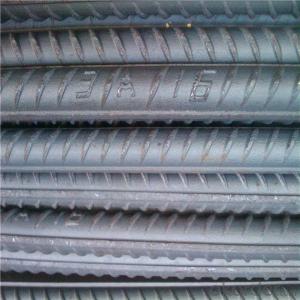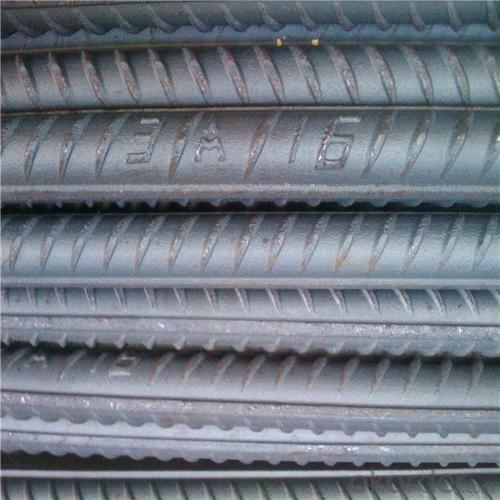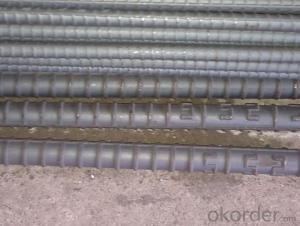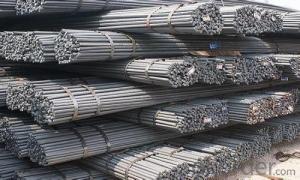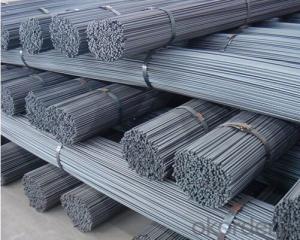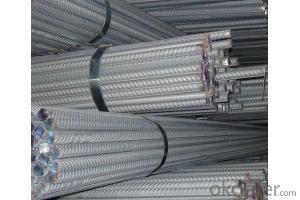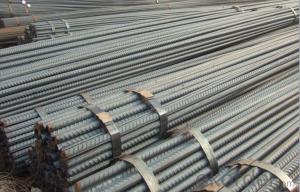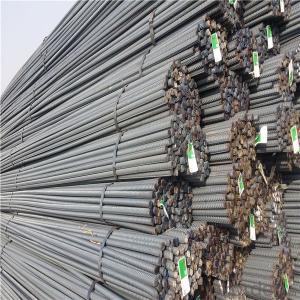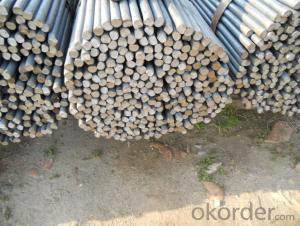China supplier Metallic material steel rebar
- Loading Port:
- China main port
- Payment Terms:
- TT OR LC
- Min Order Qty:
- 1000 m.t.
- Supply Capability:
- 17497 m.t./month
OKorder Service Pledge
OKorder Financial Service
You Might Also Like
Specification
Rebar has ridges that bind it mechanically to the concrete with friction, it can still be pulled out of the concrete
under high stresses, an occurrence that often precedes a larger-scale collapse of the structure. To prevent such
a failure, rebar is either deeply embedded into adjacent structural members, or bent and hooked at the ends to lock
it around the concrete and other rebars. This first approach increases the friction locking the bar into place while the
second makes use of the high compressive strength of concrete.
Rebar is common steel reinforcing bar, an important component of reinforced concrete and reinforced masonry structures.
It is usually formed from mild steel, and is given ridges for better frictional adhesion to the concrete
Product Description :
Chemical composition (%): | Steel | C | Si | Mn | P | S | Ceq | ||||
HRB335 |
0.25 |
0.80 |
1.60 |
0.045 |
0.045 | 0.52 | |||||
HRB400 | 0.54 | ||||||||||
HRB500 | 0.55 | ||||||||||
Mechanical properties | Steel | Rel/ MPa | Rm/ MPa | A/ % | Agt/ % | ||||||
≥ | |||||||||||
HRB335 | 335 | 455 | 17 |
7.5 | |||||||
HRB400 | 400 | 540 | 16 | ||||||||
HRB500 | 500 | 630 | 15 | ||||||||
Package: | Standard export packing or as customer's request | ||||||||||
Application: | Construction, building, bridge, road. ect | ||||||||||
Payment terms | 1).100% irrevocable L/C at sight. | ||||||||||
Delivery time | 15-30 days after receipt of L/C or deposit by T/T | ||||||||||
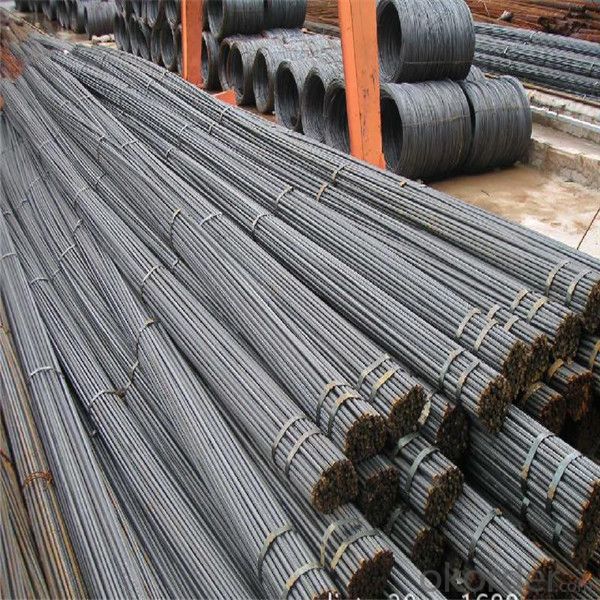
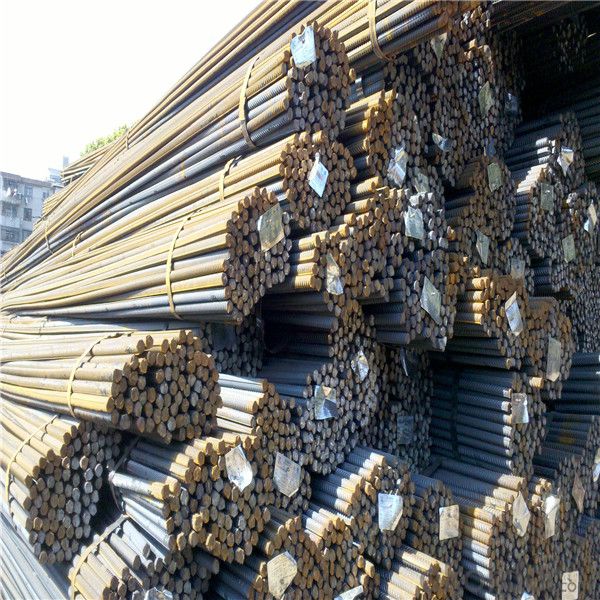
Features
1、Pure steel quality, stable chemical contents, small tolerance.
2、Constant Quality, good drawing performance.
3、High dimension accuracy degree, accuracy degree of Level C up to 80%, smooth surface, less scale, easy to be pickled.
4、Automatic bundling with 4 lines by Machine in tidy and good looks
5、Big high quality percentage, small coil percentage, and heavy coil weight for Hard Coil.
6、High sorbitizing percentage.
Packing:
In bundles, each bundle weight 3.5 tons. Load by container or by bulk verssel.
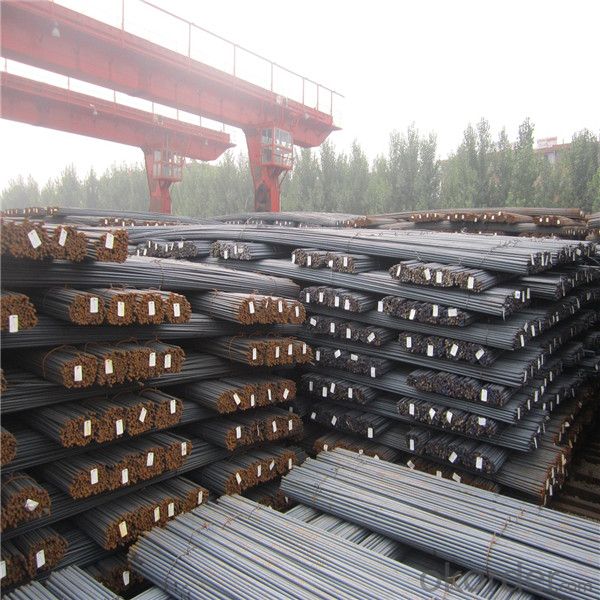

FAQ:
1.Q: What's your MOQ(minimum order quantity)?
A: One full container, mixed acceptable .
2. Q: What's your packing methods?
A: Packed in bundle or bulk ..
3. Q: How can I buy CNBM products in my country?
A:Please send us an inquiry or email ,we will reply to you if there is distributor in your country
4. Q: Can we visit your factory?
A: Warmly welcome. Once we have your schedule, we will arrange the professional sales team to follow up your case.
5. Q: How long does it take to get the product if i place an order?
A:With the process of your requirements,we will pack and deliver in 3-7 days. If it is by sea shipment,it will take 15-45 days depending on different locations
- Q: How do steel rebars contribute to the load-bearing capacity of structures?
- Steel rebars contribute to the load-bearing capacity of structures by providing reinforcement and strength to concrete. When embedded within the concrete, rebars increase its tensile strength, allowing it to withstand higher loads and prevent cracking or collapsing. This reinforcement enhances the overall structural integrity and durability of buildings, bridges, and other construction projects.
- Q: What is the purpose of steel rebars?
- The purpose of steel rebars is to reinforce and strengthen concrete structures. Rebars, also known as reinforcing bars, are steel rods or wires that are used to provide additional strength to concrete by acting as a tension device. When embedded within the concrete, rebars help to distribute the applied loads more evenly, preventing the concrete from cracking or failing under pressure. This reinforcement is particularly important in structures such as buildings, bridges, and highways that are subjected to heavy loads or potential stress, as it enhances their durability and structural integrity. Steel rebars are widely used in construction projects as they are strong, durable, and resistant to corrosion, making them an essential component for ensuring the long-term stability and safety of concrete structures.
- Q: How are steel rebars installed in construction projects?
- Steel rebars are installed in construction projects by first determining the required length and size of the rebars. Then, the rebars are cut to the appropriate lengths and bent into the desired shapes. They are then placed and secured within the concrete forms or structures, ensuring proper spacing and alignment as specified in the construction plans. Finally, the rebars are tied together using wire or mechanical connectors to create a strong reinforcement framework before the concrete is poured or applied.
- Q: Can steel rebars be used in the construction of airport runways and taxiways?
- Yes, steel rebars can be used in the construction of airport runways and taxiways. Rebars provide reinforcement and strength to concrete structures, making them suitable for heavy-duty applications such as airport pavements.
- Q: Are steel rebars suitable for use in historical restoration projects?
- Yes, steel rebars can be suitable for use in historical restoration projects. They provide structural reinforcement and can help strengthen deteriorated or weakened elements of historical buildings. However, careful consideration should be given to ensure that the use of steel rebars aligns with the original materials and techniques used in the construction of the historical structure. Additionally, the visual impact and authenticity of the restored elements should be taken into account, as steel rebars may not always be ideal for maintaining the historical integrity of the building.
- Q: What are the factors that affect the strength of steel rebars?
- The strength of steel rebars can be affected by several factors. These factors include the composition of the steel bar, the manufacturing process used, the size and shape of the rebar, heat treatment processes, corrosion, and the loading conditions applied to the rebars. The composition of the steel bar is crucial in determining its strength. Steel rebars typically contain carbon, with a content ranging from 0.15% to 0.6%. This carbon content affects the hardness and strength of the rebar. Additionally, other elements such as manganese, silicon, and sulfur can also impact the rebar's strength. The manufacturing process used to produce the steel rebars can also influence their strength. Hot rolling is commonly employed, which involves heating the steel billets to high temperatures and shaping them by passing them through rollers. The cooling rate during this process can cause variations in the internal microstructure of the bar, resulting in differences in strength. The size and shape of the rebar are significant factors in determining its strength. Thicker and larger diameter rebars generally have higher strength capacities compared to thinner ones. Furthermore, the shape of the rebar, whether it is a plain round bar or has deformations like ribs, can also impact its strength. Heat treatment processes can be applied to steel rebars to enhance their strength. For example, quenching and tempering involve heating the rebar to a high temperature and then rapidly cooling it, increasing its strength and hardness. The specific heat treatment process used depends on the desired strength requirements. Corrosion can significantly reduce the strength of steel rebars over time. When exposed to moisture and oxygen, steel rebars can rust, leading to structural degradation. Proper corrosion protection measures, such as epoxy coating or galvanization, are essential for maintaining the strength and durability of the rebars. The type and magnitude of the applied loads also influence the strength of steel rebars. Different applications require rebars with varying strength capacities. Therefore, the design and engineering of structures should consider the expected loads to determine the appropriate strength of the rebars used. In conclusion, the strength of steel rebars is influenced by their composition, manufacturing process, size and shape, heat treatment, corrosion protection, and the loading conditions they will experience. It is crucial to consider these factors when selecting and using steel rebars in construction projects.
- Q: Are steel rebars suitable for use in high-temperature applications?
- Steel rebars are generally not suitable for use in high-temperature applications. Although steel is a strong and durable material, it has limitations when exposed to high temperatures. At elevated temperatures, steel can undergo significant reduction in strength and may even experience a loss of structural integrity, leading to potential failures. When steel is exposed to high temperatures, it undergoes a process called thermal expansion, which can cause it to weaken and deform. This phenomenon is particularly prominent in rebars, which are often used as reinforcements in concrete structures. The high temperatures can cause the rebars to expand and exert excessive pressure on the surrounding concrete, leading to cracks and potentially compromising the structure's stability. Additionally, prolonged exposure to high temperatures can result in a loss of the steel's mechanical properties, including tensile strength and load-bearing capacity. This can significantly reduce the rebars' ability to resist external forces and effectively reinforce the concrete. Therefore, it is generally recommended to use alternative materials, such as stainless steel or special alloys, for high-temperature applications. These materials are specifically designed to withstand elevated temperatures without losing their structural integrity. It is important to consult with experts and engineers familiar with high-temperature applications to determine the most suitable materials for specific projects to ensure safety and structural stability.
- Q: What are the disadvantages of using steel rebars?
- One disadvantage of using steel rebars is their susceptibility to corrosion. Over time, exposure to moisture and chemicals can cause the rebars to rust, weaken, and compromise the structural integrity of the reinforced concrete. Additionally, steel rebars are heavy and difficult to handle, which can increase labor and construction costs. Lastly, steel rebars are a finite resource, and their production contributes to environmental pollution and depletion of natural resources.
- Q: Can steel rebars be used in structures with high chemical resistance requirements?
- Steel rebars can be used in structures with high chemical resistance requirements, but it is important to consider the specific chemical environment in which the structure will be exposed. While steel rebars are generally resistant to many common chemicals, certain aggressive chemical substances, such as acids or alkaline solutions, can cause corrosion and degradation of the rebar over time. In such cases, it may be necessary to use alternative materials like stainless steel rebars or fiber-reinforced polymer (FRP) rebars, which possess superior resistance to chemical attack. Additionally, proper design, construction, and maintenance practices should be implemented to mitigate the effects of chemical exposure on steel rebars. Factors such as the type and concentration of chemicals, temperature, humidity, and exposure duration should all be carefully considered to determine the suitability of steel rebars for a structure with high chemical resistance requirements. Consulting with a structural engineer or corrosion specialist is recommended to ensure the best choice of materials for the specific chemical environment.
- Q: Are there any alternative materials to steel rebars?
- Yes, there are several alternative materials to steel rebars. Some commonly used alternatives include fiberglass, carbon fiber, and basalt rebars. These materials offer advantages such as corrosion resistance, high tensile strength, and thermal stability, making them suitable for various construction applications. However, their cost and availability may vary compared to traditional steel rebars.
Send your message to us
China supplier Metallic material steel rebar
- Loading Port:
- China main port
- Payment Terms:
- TT OR LC
- Min Order Qty:
- 1000 m.t.
- Supply Capability:
- 17497 m.t./month
OKorder Service Pledge
OKorder Financial Service
Similar products
Hot products
Hot Searches
Related keywords
